When a walking boot disrupts your sleep, you have several immediate options for relief. You can strategically loosen the straps to reduce pressure, use pillows to elevate your leg which can decrease swelling, and take the boot off for about an hour before you go to sleep to give your skin a break. Additionally, managing pain proactively and adjusting your bedding can make a significant difference.
The core challenge is balancing the medical necessity of immobilization with the biological need for restful sleep. The solution lies not in simply enduring discomfort, but in making precise adjustments to your boot and sleep environment to support both healing and rest.

Why Nighttime Discomfort Occurs
To solve the problem, it helps to understand its source. The discomfort you feel is often a combination of a few key factors that are more pronounced when you are lying down for an extended period.
The Goal of Immobilization
A walking boot is designed to keep your foot and ankle in a fixed, neutral position. While this is essential for healing fractures or severe sprains, it is an unnatural state that can create pressure points and muscle stiffness.
Changes in Your Body at Rest
When you lie down, your body's fluid dynamics change. This can sometimes lead to an increase in swelling or a shift in how the boot's pressure is distributed across your foot and leg, causing new points of discomfort.
The Impact on Sleep Posture
The boot's rigid and bulky nature forces you into specific sleeping positions, most often on your back. This restriction can cause secondary aches in your hips, back, or other leg from holding an awkward posture.
Practical Strategies for Comfortable Sleep
You can implement several adjustments tonight to improve your comfort level without compromising the boot's effectiveness.
Loosen the Straps Strategically
Your foot may swell slightly at night. Loosen the straps just enough to relieve pressure while ensuring your foot remains securely in place. The boot should feel snug, not constricting.
Elevate for Comfort and Reduced Swelling
Place one or two pillows under your injured leg. The goal is to elevate your foot slightly above the level of your heart. This uses gravity to help reduce swelling and can alleviate a throbbing sensation.
Take a Calculated Break
As recommended, removing the boot for an hour before getting into bed allows your skin to breathe and relieves all pressure points. This simple reset can make a large impact, but be sure to put it back on before you fall asleep.
Manage Your Sleep Environment
A common issue is overheating. Keep your booted leg on top of the blankets to allow for better airflow. This prevents the synthetic materials from trapping heat and moisture against your skin.
Use Proactive Pain Management
If your doctor has approved pain medication, take it about 30-60 minutes before you plan to sleep. This allows the medication to take effect before you lie down, preventing pain from keeping you awake in the first place.
Understanding the Trade-offs
While these adjustments are effective, they must be done correctly to avoid creating new problems.
The Risk of Loosening Too Much
The primary function of the boot is to prevent movement. If you loosen the straps to the point where your foot can shift or rotate inside, you risk delaying or disrupting the healing process.
When to Consult Your Doctor
These tips are for managing general discomfort. If you experience sharp, escalating pain, numbness, tingling, or discoloration, it may be a sign of a more serious issue like circulation problems. Contact your doctor immediately in these cases.
Making the Right Choice for Your Goal
Select your strategy based on the specific type of discomfort you are feeling.
- If your primary focus is managing swelling: Prioritize consistent elevation with pillows to keep your foot above your heart.
- If your primary focus is relieving pressure points: Concentrate on strategically loosening the straps and taking that one-hour break before bed.
- If your primary focus is general aches and overheating: Adjust your bedding for better airflow and consider proactive pain management before sleep.
By actively managing these factors, you can reclaim your rest and ensure your recovery stays on track.
Summary Table:
| Discomfort Type | Recommended Strategy | Key Benefit |
|---|---|---|
| Swelling | Elevate leg with pillows above heart level | Reduces throbbing and fluid buildup |
| Pressure Points | Loosen straps strategically & take a 1-hour pre-bed break | Relieves constriction and allows skin to breathe |
| Overheating/Aches | Keep boot outside blankets & manage pain proactively | Improves airflow and prevents pain from disrupting sleep |
Need a Walking Boot That Prioritizes Comfort?
As a large-scale manufacturer, 3515 produces a comprehensive range of high-quality, therapeutic footwear designed for optimal patient comfort and effective recovery. Our boots are engineered to provide superior immobilization while minimizing pressure points and overheating.
For distributors, brand owners, and bulk clients: Partner with us to offer your customers a better healing experience. We can customize solutions to meet your specific market needs.
Contact our team today to discuss your requirements and discover how 3515 can support your business with reliable, comfortable footwear solutions.
Visual Guide

Related Products
- Safety Footwear Wholesale Manufacturer for Custom OEM/ODM Production
- Premium Grain Leather Safety Boots for Bulk Supply
- Premium Wholesale Wheat Nubuck Safety Boot with Rapid Lacing System
- Customizable Anti-Smash Safety Boots for Wholesale & Private Label Manufacturing
- Custom Wholesale Leather Safety Boots Direct Factory Manufacturing
People Also Ask
- How long can you wear safety boots? The Lifespan is Determined by Wear, Not Time
- Do snake bite boots work? Your Ultimate Guide to Effective Snake Bite Protection
- Is safety-toe as good as steel toe? Choose the Right Protection for Your Job
- What are OSHA approved shoes? Understanding the Correct Standards for Workplace Safety
- Is it normal to wear shoes in the house? A Guide to Hygiene, Comfort & Culture



















